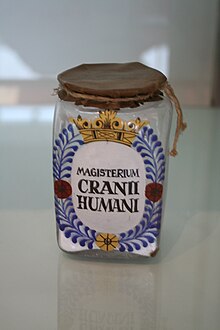Cranium humanum
Cranium humanum ( Latin for human skull ) is a medicinal substance made from human skulls that has been used in European medicine for many centuries . It was described in numerous pharmacopoeias from the 16th to 18th centuries and, in the course of the scientific advancement of medicine, completely lost its importance as a medicine from the 18th century.
background
The use of cranium humanum in the medicine of the late Middle Ages and increasingly in the medicine of the Renaissance was based on the view that healing powers emerge from the omnipotence of God's creation from plant, mineral and animal substances. Thereby the human being as the coronation of creation within the animal kingdom and above all the head as the most distinguished part of the human body were assigned special healing powers . The principle of action attributed to the cranium humanum , however, was not based on its chemical or physical properties, but rather on invisible , spiritual life forces that also work beyond the death of the person. Cranium humanum did not necessarily refer to medicinal substances obtained from the human skull; it was often a synonym for other bones from the human skeleton that were used for healing purposes. Most of the bones needed to manufacture drugs came from executed people. Executioners and executioners often used this to secure an additional income by selling body parts of their delinquents to doctors or pharmacists. In addition to cranium humanum , mumia and human fat ( axungia hominis ) were often listed as medicinal substances of human origin in historical pharmacopoeias .
application
Cranium humanum was mainly used for diseases that could not be explained with the knowledge of the time and whose causes were ultimately attributed to magical or demonic influences such as paralysis , strokes , seizures , epilepsy or exceptionally heavy menstrual bleeding . In contrast to many diseases , which are seen as a god-given punishment, the attack of the patient by evil forces was the trigger, the healing of which was only possible through the expulsion of evil and a liberation of the patient with the help of the power of the cranium humanum . The Nuremberg Pharmacopoeia, for example, names Dispensarium magistri Nicolai Praepositi ad aromatarios from 1536 cranium humanum as an effective remedy against epilepsy. The 1620 in Moravia Andreas Glorez describes the application of the drug for heavy menstrual bleeding:
"Scrape or file a quentlet, and let it soak in a glass full of white wine overnight and take it soberly in the morning, always over the second day, and the flow will be stilled the second or third time."
With the increasing scientification of medicine in the 18th century, these principles of action and the use of human medicinal substances were reassessed and often assigned to quackery and charlatanry and almost completely lost their importance.
See also
literature
- Sabine Bernscheider-Reif, Timo Gruber: Cranium humanum - remedies in pharmacies in the West . In: Alfried Wieczorek, Wilfried Rosendahl (ed.): Skull cult - head and culture in the cultural history of man . Schnell and Steiner, Regensburg 2011, ISBN 978-3-7954-2455-8 , pp. 250-255 .
Individual evidence
- ↑ "because man is the most perfect of all animals" ( Christoph Glaser : Novum Laboratorium medico-chymicum. Nuremberg 1677, p. 339)
- ↑ "Caput, the head, the head of the most distinguished part of a human body" ( Johann Heinrich Zedler : Large complete Universal Lexicon of all Sciences and Arts . Leipzig, Vol. 5 1733, p. 387 and Vol. 13 1739, p. 100)
- ↑ Sabine Bernscheider-Reif, Timo Gruber: Cranium humanum - remedies in the pharmacies of the West . In: Alfried Wieczorek, Wilfried Rosendahl (ed.): Skull cult - head and culture in the cultural history of man . Schnell and Steiner, Regensburg 2011, ISBN 978-3-7954-2454-1 , p. 254 .
Web links
- Cranium humanum In: Lemery, Nicholas: Complete Lexicon of Materials. Leipzig, 1721, p. 363. On Zeno.org
